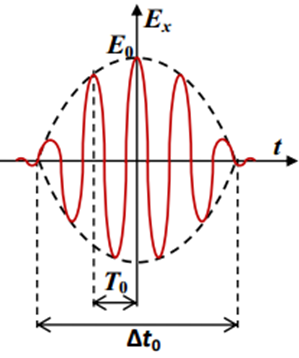
A laser is a source of coherent optical radiation. Laser radiation is generated when a large number of atoms transferred to an excited state by external action (pumping) emit photons with the same phase and polarization. A consistent theory of laser radiation is based on quantum mechanics but some aspects of this phenomenon can be understood by means of classical electrodynamics.
Let us first consider emission of a photon by a single atom. According to classical electrodynamics, an atom can be regarded as dipole emitter. In this model an electric dipole is associated with an atom comprised of an immobile atomic nucleus with a positive charge $+q$ and a negative charge $-q$ oscillating harmonically around it (the negative charge is located at the center of the charge distribution of electron cloud).
Here the atomic dipole moment oscillates according to the law $\vec p(t)=\vec p_m \cos(\omega t + \varphi)$. The cyclic oscillation frequency is related to the energy of emitted photons by the Planck relation $E_\gamma = \hbar\omega$. Hereinafter the frequency of photons means cyclic frequency. The radiation power of a classical system with a variable dipole moment $\vec P(t)$ is given by the formula
$$W=\frac{2k}{3c^3}\langle\left(\frac{d^2\vec P}{dt^2}\right)^2\rangle,$$
where the angle brackets stand for the averaging over the oscillation period.
Suppose $N$ atoms in a certain volume are transferred to an excited state by a short-term pumping action. It is known that one atom emits a photon with a frequency $\omega$ for a characteristic time $\tau$.
Pulses of even shorter duration can be obtained by reducing the duration of already generated laser pulses. A pulse duration $ \Delta t $ and a dispersion of frequency of pulse oscillations $ \Delta \omega $ (spectral width) are related by the inequality $ \Delta \omega \Delta t \ge 2 \pi $. Laser pulses generated in the superradiance mode already have the shortest possible duration for the given dispersion of frequencies, $ \Delta t_0 \approx \frac {2 \pi} {\Delta \omega_0} $. Therefore, the pulse duration can be reduced in two steps: first, increase the spectral width of the pulse (without changing the duration) and second, compress the pulse in time.
One of the most common ways to solve the first problem is pulse chirping. This method is based on the use of nonlinearity of a medium, i.e. dependence of the refractive index of the medium $ n $ on the amplitude of oscillations of the electric field $ E_m $ of the wave. The dependence is of the form $ n = n_0 + n_2E_m^2 $, where $ n_0 $ and $ n_2 $ are some constants specific for the medium. Nonlinear effects are small, e.g. in quartz at a light intensity $ I_1 = 10^9~ \mathrm{W/cm^2}$ the refractive index increases only by $ n_2E_ {m1}^2 \approx 3.2 \cdot 10^{-7}$. The intensity of an electromagnetic wave in a medium is determined by the formula $ I = \cfrac {\varepsilon_0 n_0 c} {2} E_m^2 $.

To compress a chirped pulse in time one can pass it through a medium in which the group velocity of the wave depends on its frequency. For the medium under consideration, the dependence of wavenumber on frequency in the vicinity of the mean frequency $ \omega_0 $ can be represented as $ k (\omega) = k_0 + \beta_1 (\omega- \omega_0) + \frac {\beta_2} {2} (\omega - \omega_0)^2 $, where $ \beta_1 = 5 ~ \mathrm {ns/m} $ and $ | \beta_2 | = 20~\mathrm {fs^2/mm} $.
In astronomy observations of luminous objects are being made for long periods of time. This makes it possible to study variations of their emission spectra. Spectral measurements can detect planets orbiting distant stars — "exoplanets". Exoplanets do not have their own radiation so one is bound to study radiation spectra of their stars. If the line of sight from Earth to an exoplanet lies almost in its orbital plane, such an exoplanet can be discovered by a decrease of the star brightness at a moment the exoplanet is crossing the star disk. However, if the orbital plane is tilted with respect to the direction to Earth this method does not work.